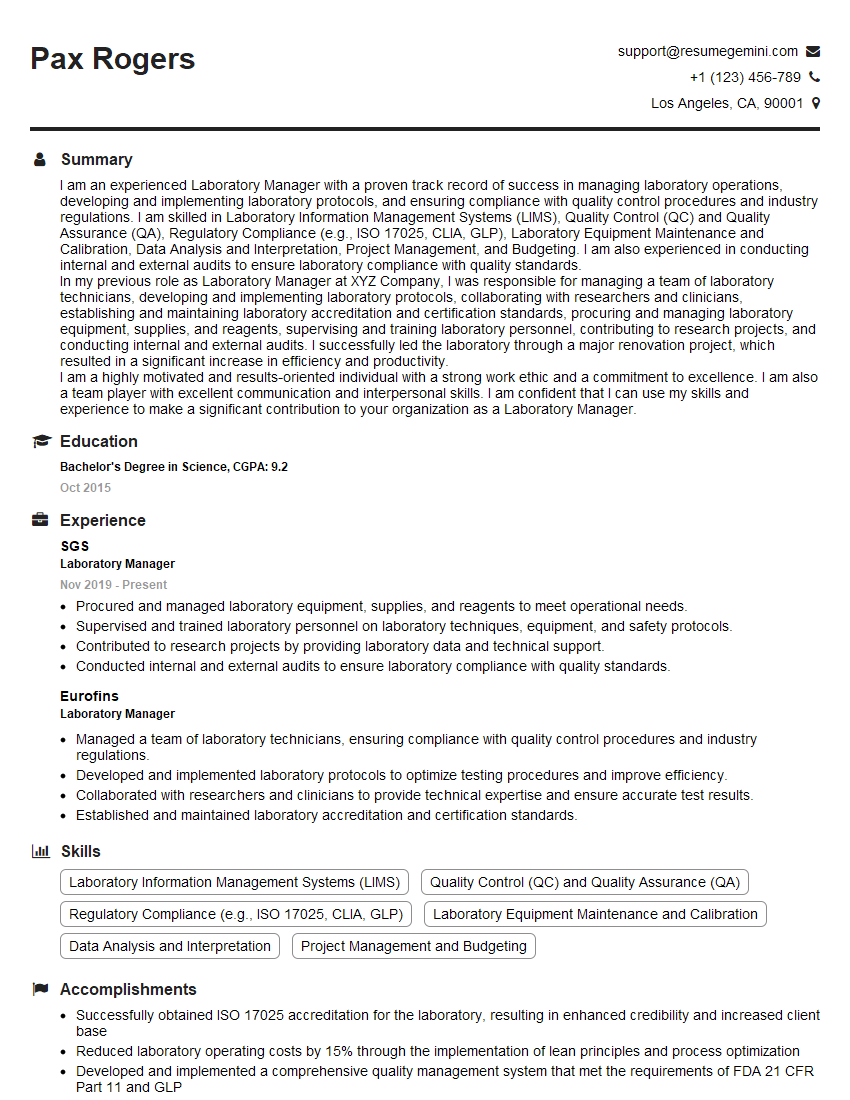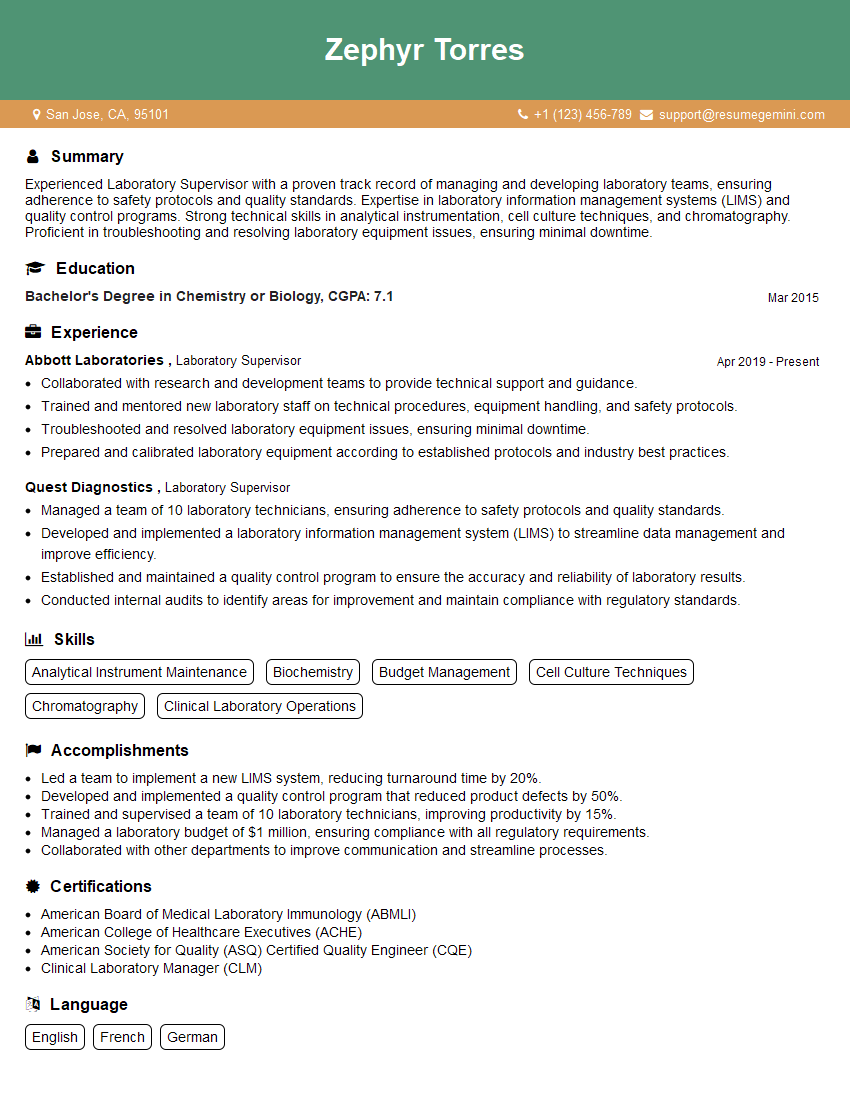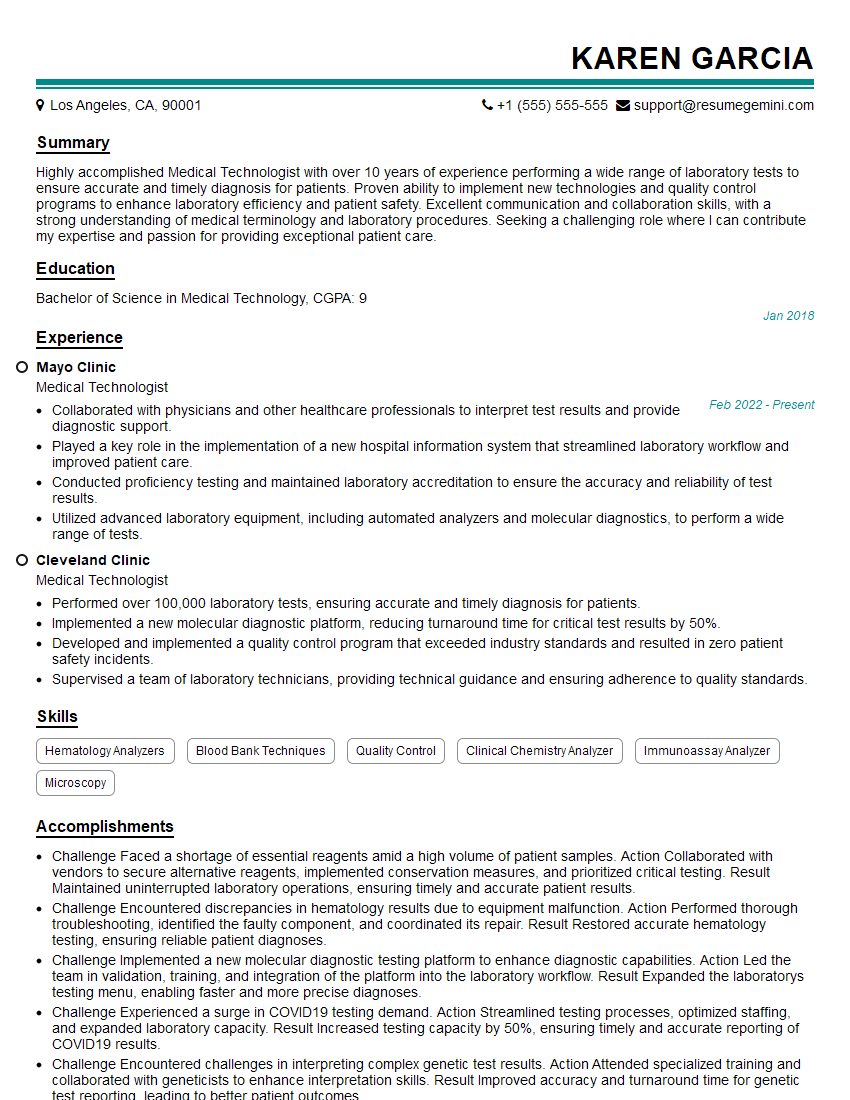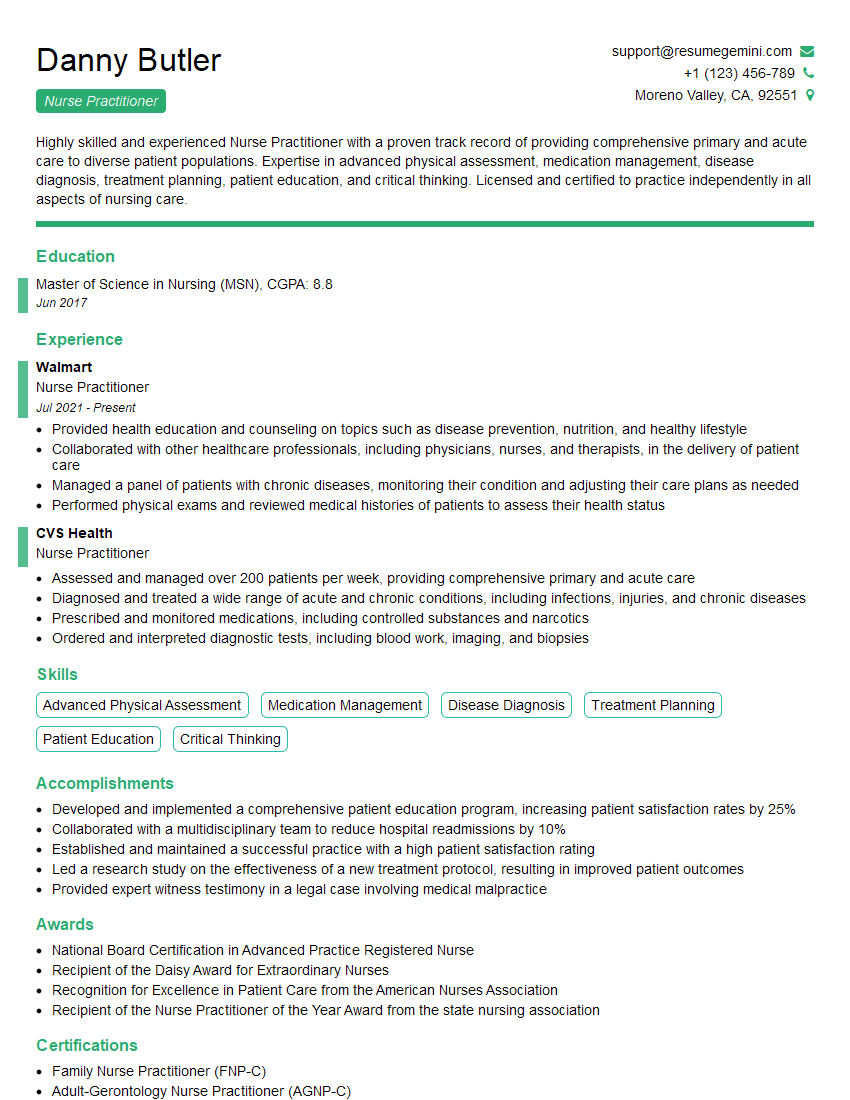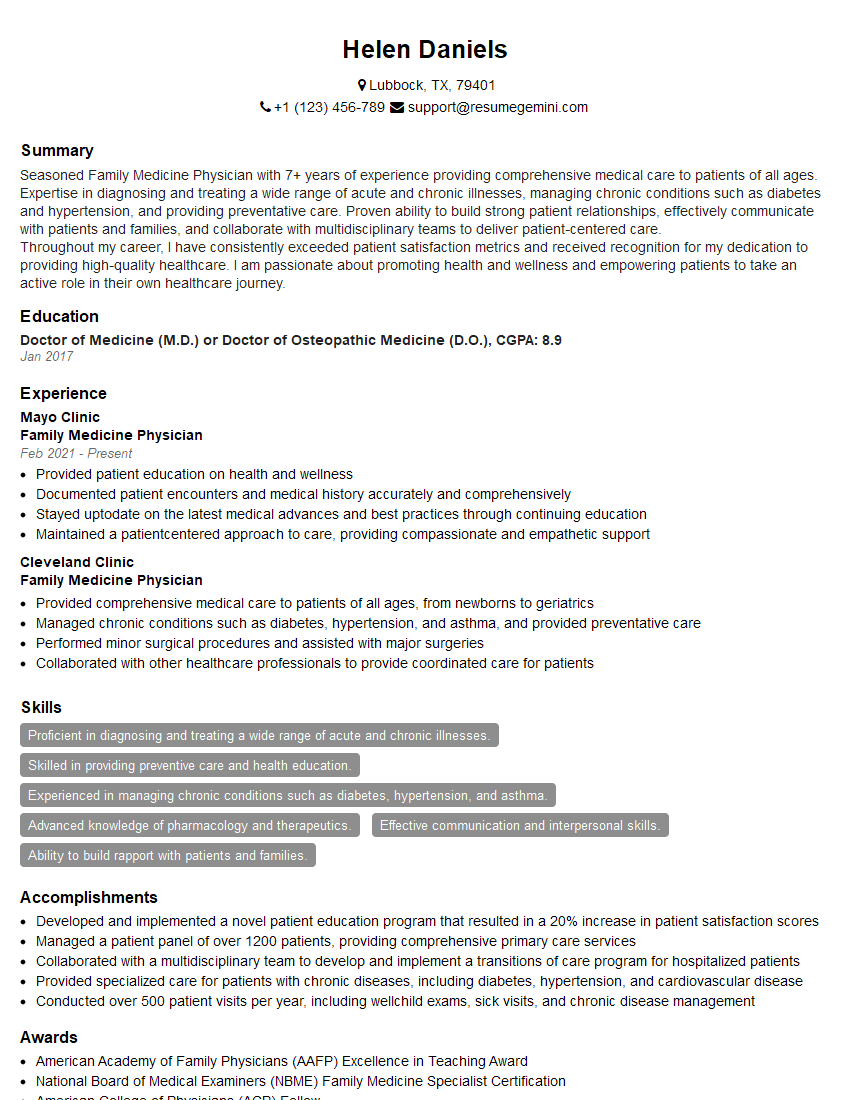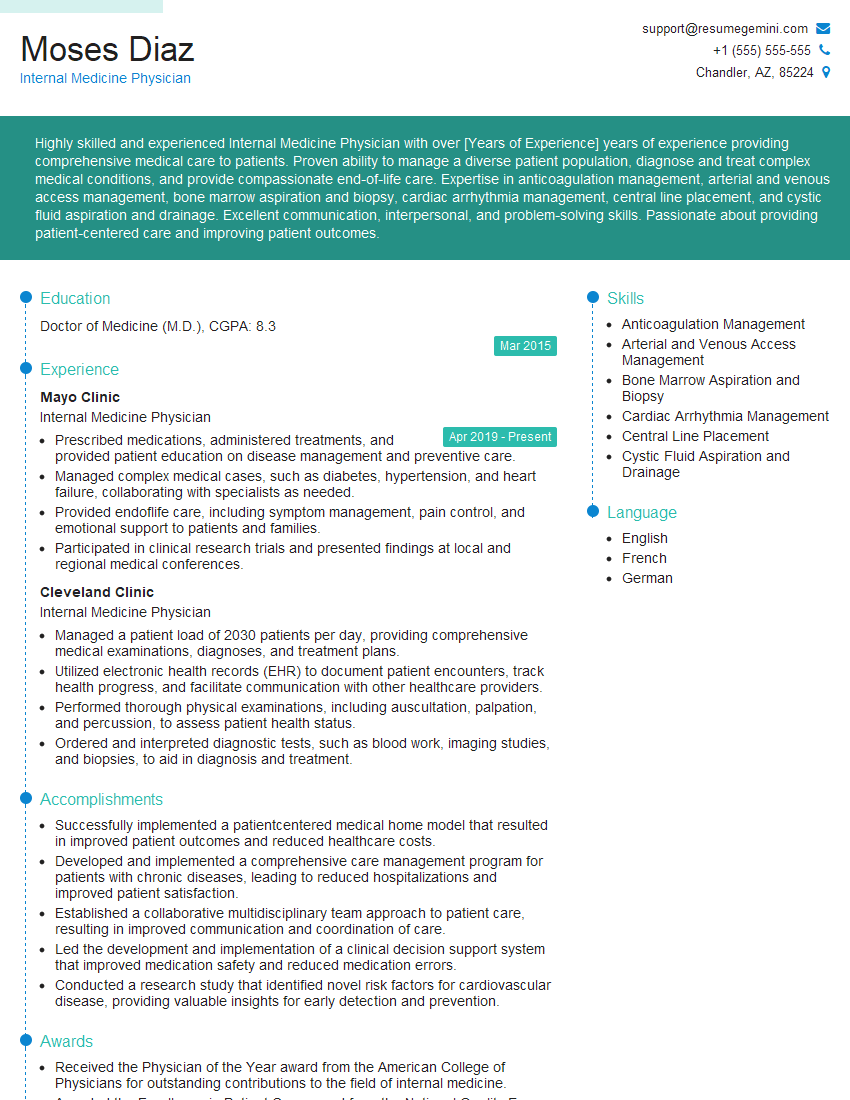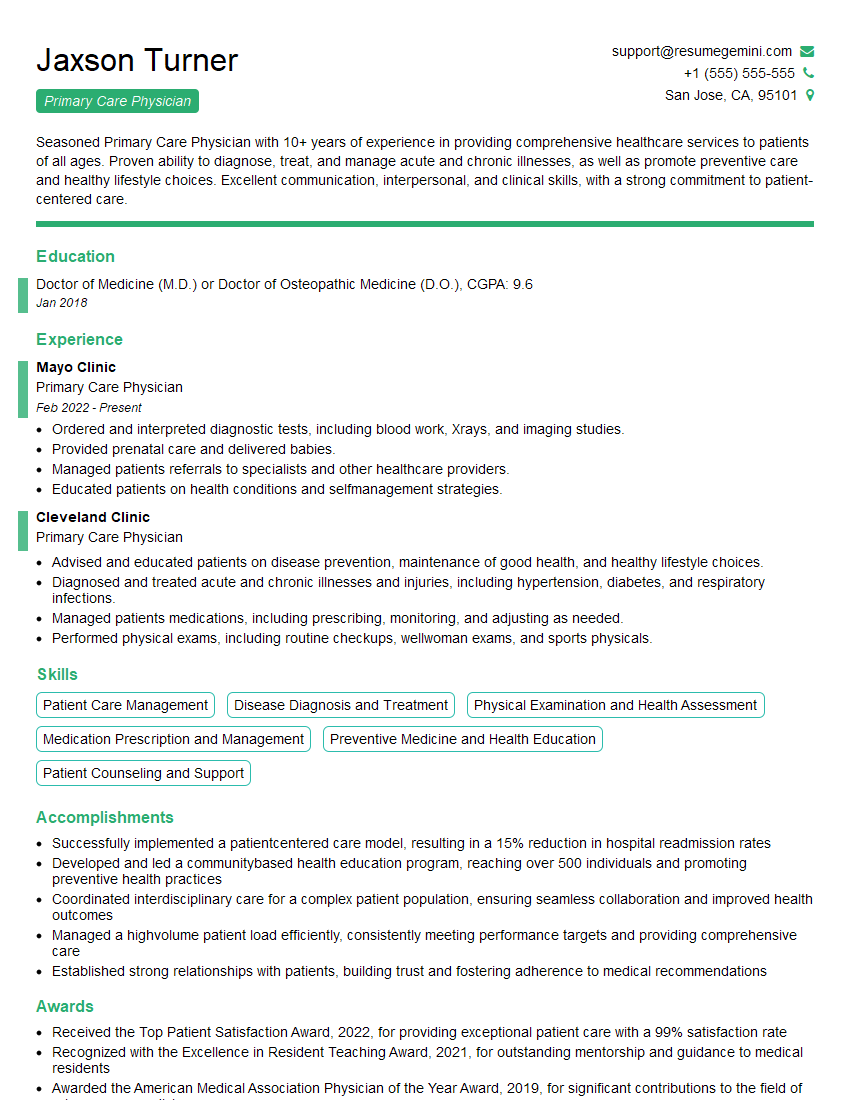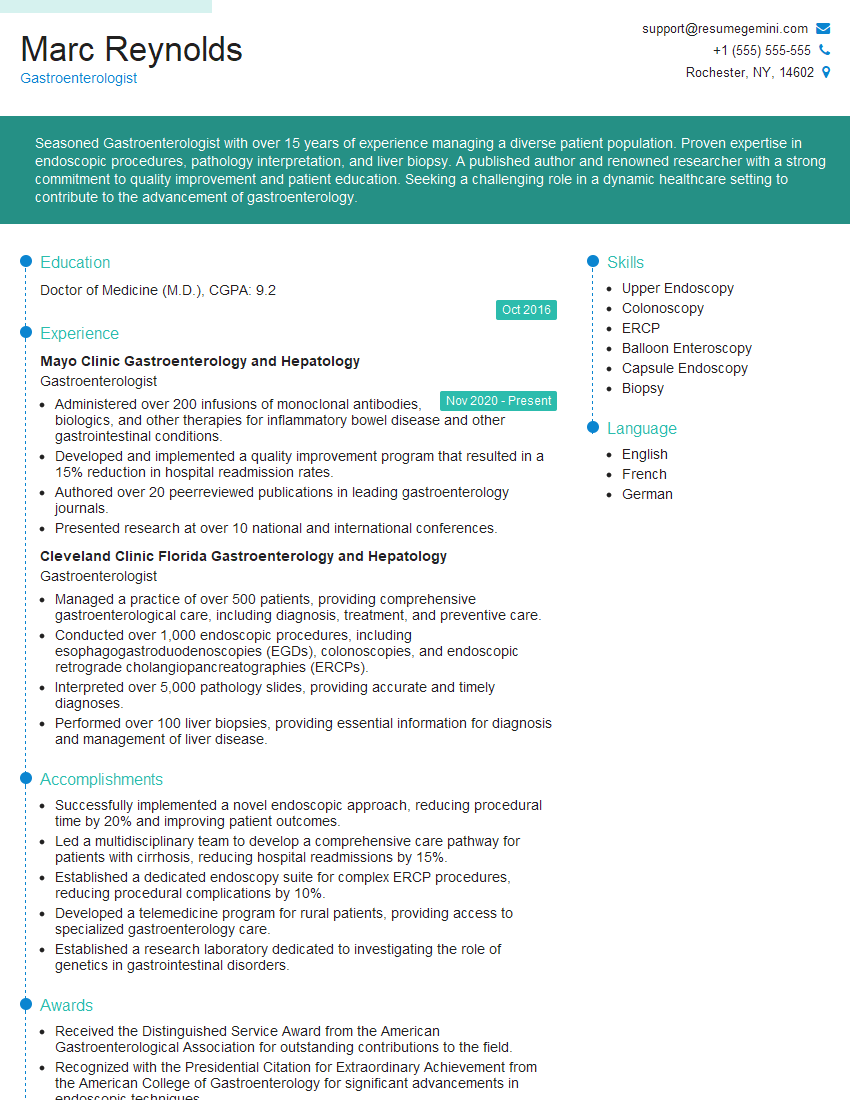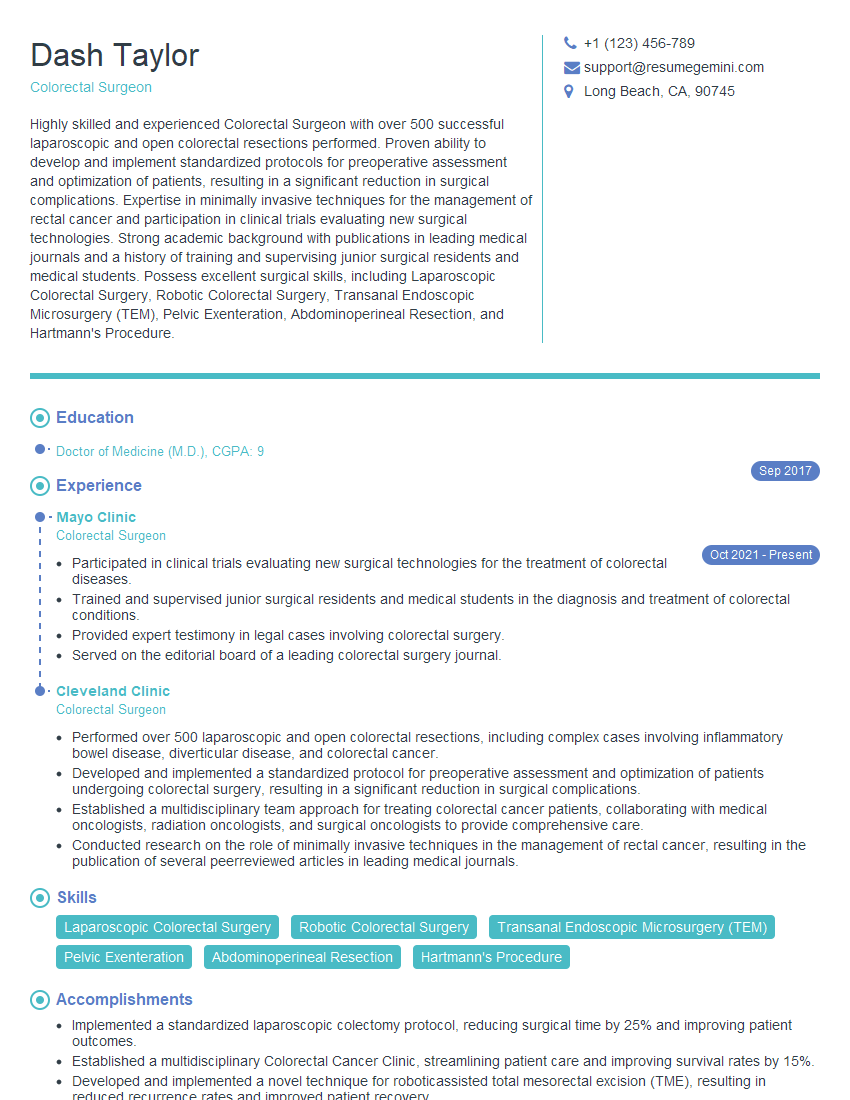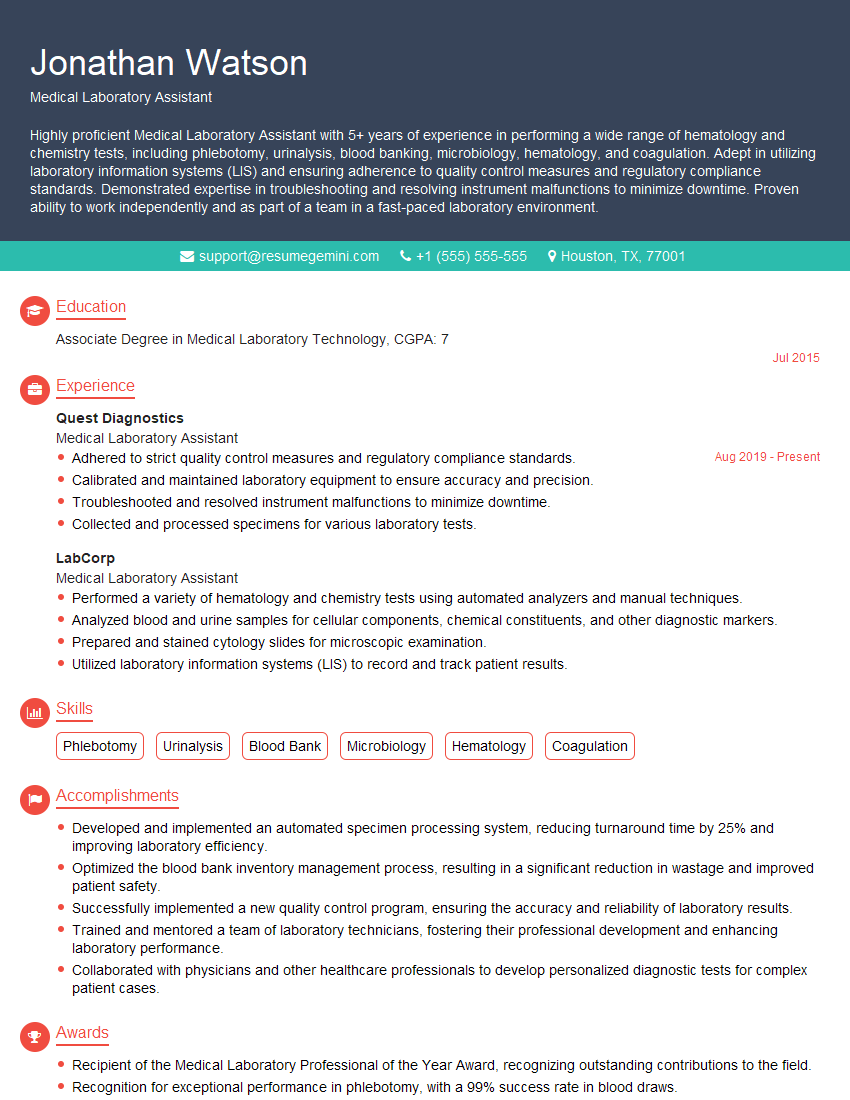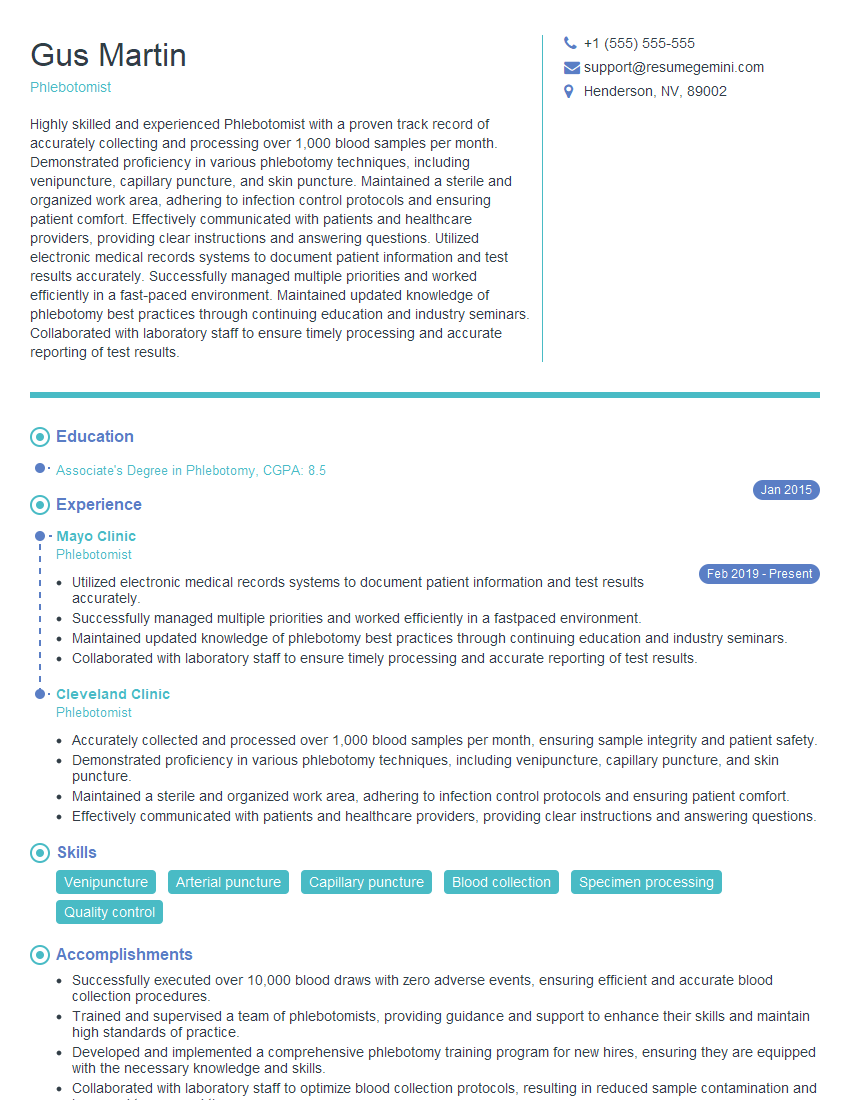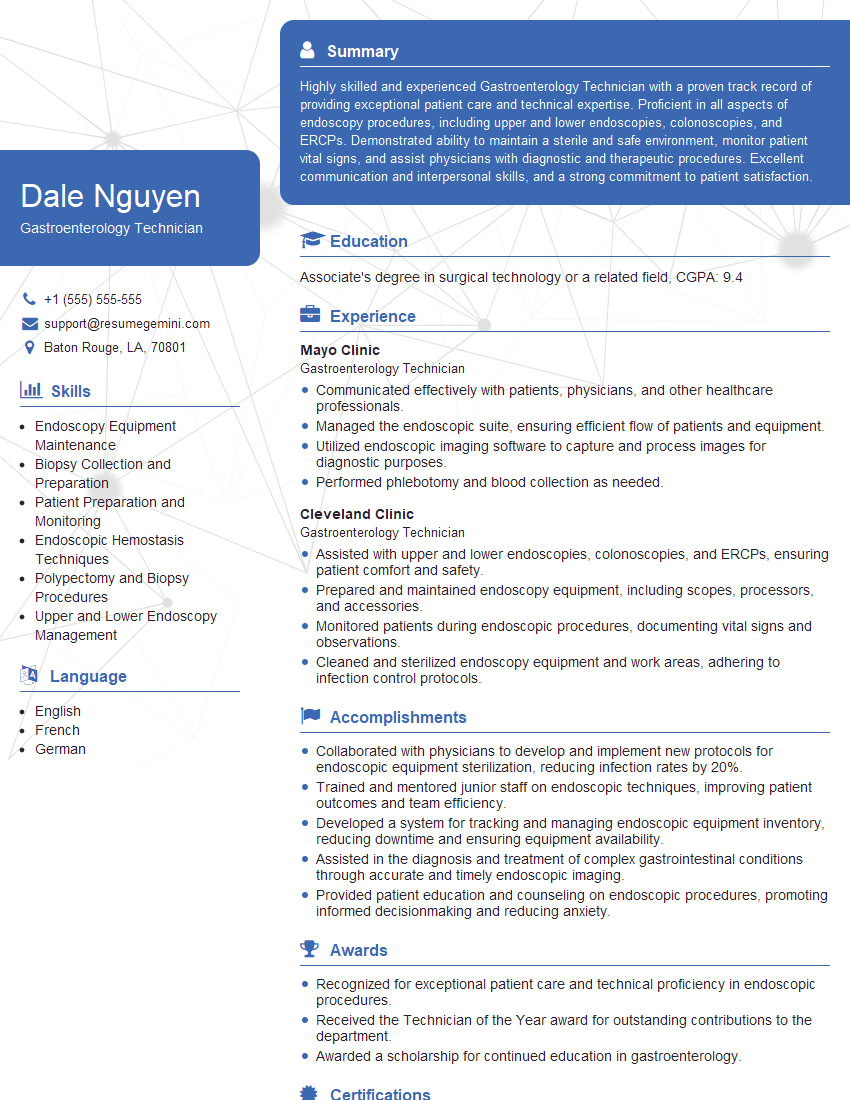Interviews are opportunities to demonstrate your expertise, and this guide is here to help you shine. Explore the essential Fecal Occult Blood Testing (FOBT) interview questions that employers frequently ask, paired with strategies for crafting responses that set you apart from the competition.
Questions Asked in Fecal Occult Blood Testing (FOBT) Interview
Q 1. Explain the principle behind Fecal Occult Blood Testing (FOBT).
Fecal occult blood testing (FOBT) is a screening test used to detect hidden (occult) blood in the stool. It works on the principle of identifying the presence of hemoglobin, a protein found in red blood cells. If there’s bleeding in the gastrointestinal tract, even if it’s microscopic, hemoglobin will be present in the stool. FOBT methods utilize different chemical reactions or immunological assays to detect this hemoglobin.
Q 2. Describe the different types of FOBT methods.
There are primarily two types of FOBT methods:
- Guaiac-based FOBT: This older method uses guaiac, a resin from a tree, that reacts with hemoglobin to produce a color change in the presence of blood. It’s a relatively inexpensive and simple test, but prone to false positives.
- Immunochemical FOBT (iFOBT): This newer method employs antibodies that specifically bind to human hemoglobin. This greater specificity leads to fewer false positives and improved sensitivity for detecting colorectal cancer. It’s more expensive but significantly more accurate.
Q 3. What are the advantages and disadvantages of guaiac-based FOBT?
Advantages of Guaiac-based FOBT:
- Cost-effective
- Simple to perform
- Widely available
Disadvantages of Guaiac-based FOBT:
- High rate of false-positive results due to dietary factors (red meat, certain vegetables) and medications.
- Lower sensitivity compared to iFOBT, meaning it might miss some instances of bleeding.
- Requires dietary restrictions before the test to minimize false positives.
For example, a patient eating a steak the day before the test could produce a false positive even if there was no underlying gastrointestinal bleeding.
Q 4. What are the advantages and disadvantages of immunochemical FOBT?
Advantages of Immunochemical FOBT:
- Higher sensitivity and specificity compared to guaiac-based FOBT, leading to fewer false positives and negatives.
- Less susceptible to dietary interference; patients don’t usually need to follow restrictive diets.
- Improved detection of colorectal cancer.
Disadvantages of Immunochemical FOBT:
- More expensive than guaiac-based tests.
- May not detect bleeding from the upper gastrointestinal tract as effectively as some other tests.
Imagine a scenario where a patient has a small polyp bleeding intermittently. iFOBT’s higher sensitivity is more likely to pick up this subtle bleeding, improving early detection.
Q 5. How do you interpret the results of an FOBT?
FOBT results are typically reported as positive or negative. A positive result indicates the presence of blood in the stool, requiring further investigation, such as colonoscopy. A negative result suggests no detectable blood. However, a negative result doesn’t guarantee the absence of gastrointestinal pathology. The result is interpreted in conjunction with the patient’s history, symptoms, and other diagnostic tests.
For example, a positive result in a patient with no symptoms could necessitate further tests like a colonoscopy to rule out serious issues.
Q 6. What are the limitations of FOBT?
Limitations of FOBT include:
- Sensitivity: FOBT might miss small amounts of bleeding, particularly in early-stage colorectal cancer.
- Specificity: False positives can occur due to dietary factors, medications, and other conditions.
- Location of Bleeding: FOBT may be less sensitive in detecting bleeding in the upper gastrointestinal tract.
- Not diagnostic: A positive result doesn’t definitively diagnose a specific condition; it only indicates the presence of blood and necessitates further investigation.
It’s crucial to remember that FOBT is a screening tool, not a diagnostic one. A positive result simply signals the need for further evaluation.
Q 7. What factors can cause false-positive FOBT results?
Several factors can lead to false-positive FOBT results:
- Diet: Consumption of red meat, certain vegetables (like radishes and horseradish), and some fruits (like beets) can cause false-positive results.
- Medications: Certain medications, such as aspirin and NSAIDs, can cause gastrointestinal bleeding and lead to a false positive.
- Menstruation: In women, menstrual blood can contaminate the stool sample.
- Hemorrhoids: Bleeding from hemorrhoids can also produce a positive result.
- Other conditions: Various conditions like diverticulitis, ulcers, and inflammatory bowel disease can cause bleeding and result in false positives.
It’s important to obtain a thorough patient history to understand potential causes of false positives and interpret the results accurately. This emphasizes the importance of considering patient history alongside the test results.
Q 8. What factors can cause false-negative FOBT results?
False-negative fecal occult blood test (FOBT) results, meaning the test doesn’t detect blood when it’s present, can stem from several factors. Imagine a tiny leak in a pipe – sometimes, the drip is too small to notice. Similarly, small amounts of bleeding may be missed.
- Insufficient bleeding: The amount of blood in the stool may be below the test’s detection threshold. This is especially true with slow, chronic bleeds.
- Interfering substances: Certain foods, like red meat, some vegetables (like broccoli, turnips), and medications (such as aspirin and nonsteroidal anti-inflammatory drugs – NSAIDs) can cause a false-negative by masking the blood signal. Think of it like adding too much spice to a dish – you might miss the subtle flavors.
- Improper test technique: Incorrect collection, storage, or handling of the sample can impact results. A contaminated sample or improper timing can dilute the blood signal, leading to a false negative.
- Vitamin C interference: High Vitamin C intake can interfere with the chemical reaction that detects blood, resulting in a false negative. The Vitamin C acts as an antioxidant, reducing the oxidation of the hemoglobin and thus its detection.
- Test sensitivity limitations: Even with proper technique and a significant bleed, some FOBT tests might not be sensitive enough to pick up blood in all cases.
Understanding these factors is crucial for interpreting results and taking appropriate follow-up actions. If a patient has a high clinical suspicion for bleeding despite a negative FOBT, alternative tests like colonoscopy may be necessary.
Q 9. How do you prepare a patient for an FOBT?
Preparing a patient for an FOBT involves clear instructions to ensure accurate and reliable results. It’s like preparing a clean canvas for painting – we need a clear background to see the details.
- Dietary restrictions: Patients should avoid red meat, certain vegetables (broccoli, turnips, etc.), and potentially other foods that can interfere with the test for several days before the test. A list of restricted foods should be provided.
- Medication review: A review of medications is crucial to identify those that can cause false positives or negatives. The physician should consider holding certain medications if possible, before the test.
- Sample collection instructions: Patients should be thoroughly educated on how to correctly collect the sample using the provided collection device, ensuring representative portions of stool are collected for testing.
- Understanding of potential side effects: The patient should be informed that, despite rigorous preparation, there’s a possibility of false-negative or false-positive results. Emphasizing the importance of reporting any abnormal symptoms is critical.
Clear communication and patient education are paramount for successful FOBT. A well-informed patient is more likely to adhere to instructions, contributing to better results.
Q 10. What are the proper collection and handling procedures for FOBT samples?
Proper collection and handling of FOBT samples are critical to prevent contamination and maintain the integrity of the test results. Think of it like preserving a delicate piece of artwork – every step counts.
- Collection: Use the provided collection device according to the manufacturer’s instructions, collecting small stool samples from different parts of the stool specimen.
- Storage: Store the samples according to instructions; this usually involves protecting them from light and excessive heat. Improper storage can degrade the sample.
- Transportation: Transport the samples immediately to the lab for testing, usually following the instructions provided with the kit. Delaying transportation can impact results.
- Documentation: Thorough documentation of the collection, storage, and transport processes is needed, including the patient’s information and the time of each step.
- Avoid contamination: Prevent contamination by using clean gloves and avoiding contact with urine or other bodily fluids.
Adherence to these protocols minimizes false results and ensures reliable interpretation. Documentation provides a verifiable trail for the entire process.
Q 11. Describe the quality control measures used in FOBT testing.
Quality control measures in FOBT are vital to ensure reliable results. This involves consistent monitoring and verification of the entire testing process, from sample collection to result interpretation.
- Positive and negative controls: Each test batch includes positive (known to contain blood) and negative (known to be blood-free) controls to validate the test’s performance. It’s like checking your tools before starting a job.
- Reagent stability: Regularly checking the expiry dates and storage conditions of testing reagents to ensure their effectiveness. Expired or improperly stored reagents can produce unreliable results.
- Calibration checks: Depending on the test methodology, calibration checks may be required to ensure consistent measurement across all tests.
- Technician training and competency: Well-trained personnel are crucial to minimize errors in sample handling and test performance.
- Regular equipment maintenance: Depending on the type of testing equipment used, regular preventative maintenance is necessary to ensure consistent performance.
These measures help identify and correct potential issues, enhancing the accuracy and reliability of FOBT results.
Q 12. How do you ensure the accuracy and reliability of FOBT results?
Ensuring accuracy and reliability in FOBT involves a multifaceted approach, encompassing meticulous attention to detail at every stage of the process. It’s like baking a cake; each ingredient and step affects the final outcome.
- Proper patient preparation: Following a strict protocol in educating and preparing patients for the test, as already discussed.
- Strict adherence to testing procedures: Precisely following manufacturer’s instructions for sample collection, handling, and testing.
- Effective quality control: Implementing the quality control measures outlined earlier, allowing for the early identification and resolution of potential problems.
- Interpretation of results in context: Results should always be interpreted considering patient history, symptoms, and other diagnostic findings. A single positive FOBT shouldn’t trigger immediate alarm without further investigations.
- Consideration of alternative tests: If there’s clinical suspicion of bleeding despite negative FOBT, alternative testing (e.g., colonoscopy) should be considered.
A combination of these steps minimizes errors and enhances the confidence in the results, guiding appropriate clinical decisions.
Q 13. What are the potential sources of error in FOBT testing?
Potential sources of error in FOBT can arise from various points in the testing process, and recognizing these sources is crucial for accurate interpretation. It’s like understanding the potential pitfalls in a complex recipe.
- Pre-analytical errors: These occur before the actual testing, such as improper patient preparation (diet, medications), incorrect sample collection, or inadequate storage and transportation of the sample.
- Analytical errors: Errors during the testing process itself, which might include reagent issues, instrument malfunction, or incorrect test performance.
- Post-analytical errors: These are errors that happen after the test, such as misinterpretation of results, incorrect reporting, or failure to correlate the findings with other clinical data.
- Human error: Mistakes made by personnel at any stage of the process, from patient instruction to result reporting, can significantly affect results. This emphasizes the importance of well-trained staff.
By identifying these potential sources, we can develop strategies to minimize their impact and improve the overall accuracy of FOBT testing.
Q 14. How do you troubleshoot common problems encountered in FOBT testing?
Troubleshooting problems in FOBT requires a systematic approach, investigating each step of the process to pinpoint the cause. It’s like detective work, following clues to solve a mystery.
- Review the patient’s preparation: Check if the patient followed dietary restrictions and medication guidelines. A missed instruction may have led to inaccurate results.
- Examine the sample collection and handling: Assess whether the sample was collected properly and stored appropriately. Improper handling can introduce errors.
- Verify testing procedures: Ensure that the testing procedure was followed correctly, and that the reagents and equipment were used correctly and were not expired.
- Review quality control measures: Check the performance of positive and negative controls to verify if the testing system was functioning correctly.
- Consider alternative diagnostic tests: If there are persisting discrepancies or suspicion of error, further investigations using more sensitive methods (e.g., colonoscopy) might be necessary.
A methodical approach will help identify the error source and ultimately enhance future testing accuracy.
Q 15. What is the role of FOBT in colorectal cancer screening?
Fecal Occult Blood Testing (FOBT) plays a crucial role in colorectal cancer screening by detecting microscopic amounts of blood in the stool that may not be visible to the naked eye. This hidden blood can be an early indicator of colorectal polyps or cancer, even before symptoms appear. Early detection significantly improves treatment outcomes and survival rates.
Think of it like this: a tiny leak in a pipe (a polyp or early cancer) might not cause a noticeable flood (obvious bleeding), but FOBT is sensitive enough to detect even that small leak.
Career Expert Tips:
- Ace those interviews! Prepare effectively by reviewing the Top 50 Most Common Interview Questions on ResumeGemini.
- Navigate your job search with confidence! Explore a wide range of Career Tips on ResumeGemini. Learn about common challenges and recommendations to overcome them.
- Craft the perfect resume! Master the Art of Resume Writing with ResumeGemini’s guide. Showcase your unique qualifications and achievements effectively.
- Don’t miss out on holiday savings! Build your dream resume with ResumeGemini’s ATS optimized templates.
Q 16. What are the guidelines for FOBT screening?
Guidelines for FOBT screening vary slightly depending on the specific test used (guaiac-based or immunochemical) and the individual’s risk factors. However, general guidelines typically recommend starting regular FOBT screening at age 50 for individuals at average risk. Those with a family history of colorectal cancer or other risk factors may need to start screening earlier and/or more frequently. These guidelines are often developed and updated by organizations like the American Cancer Society and the US Preventive Services Task Force, and it’s crucial to stay informed about current recommendations.
Q 17. How often should FOBT screening be performed?
For average-risk individuals, FOBT screening is usually recommended annually. However, if a person has a family history of colorectal cancer or other risk factors, their doctor might recommend more frequent testing, or recommend an alternative screening method altogether, such as colonoscopy.
The frequency is a crucial factor in early detection, just like regular oil changes keep your car running smoothly; regular FOBT helps monitor bowel health.
Q 18. What are the alternative screening methods for colorectal cancer?
FOBT is just one of several methods for colorectal cancer screening. Alternatives include:
- Colonoscopy: A visual examination of the entire colon using a flexible tube with a camera. This is considered the gold standard, allowing for direct visualization and removal of polyps.
- Sigmoidoscopy: Similar to colonoscopy, but only examines the lower part of the colon (sigmoid colon).
- CT Colonography (Virtual Colonoscopy): A non-invasive imaging technique using X-rays to create 3D images of the colon.
- Stool DNA tests: These newer tests detect abnormal DNA shed from colorectal tumors in the stool.
The best method depends on individual risk factors, patient preference, and access to resources.
Q 19. Discuss the sensitivity and specificity of FOBT compared to other screening methods.
Compared to other methods, FOBT has lower sensitivity and specificity. Sensitivity refers to the test’s ability to correctly identify those with colorectal cancer (true positives). Specificity refers to its ability to correctly identify those without the disease (true negatives). FOBT might miss some cancers, resulting in false negatives, and may produce false positives due to various factors like diet (red meat).
Colonoscopy boasts significantly higher sensitivity and specificity but is more invasive. Stool DNA tests are becoming increasingly sensitive and are less invasive.
Think of it like a metal detector at the airport: a colonoscopy is like a thorough pat-down, while FOBT is a quick sweep; it might miss smaller items (early cancers) but is less intrusive.
Q 20. How do you interpret a positive FOBT result?
A positive FOBT result indicates the presence of blood in the stool. This does not automatically mean colorectal cancer. Many other conditions, such as hemorrhoids, diverticulitis, and inflammatory bowel disease, can also cause blood in the stool. A positive result simply warrants further investigation.
Q 21. What are the next steps after a positive FOBT result?
A positive FOBT result necessitates follow-up testing to determine the source of the bleeding. This typically involves a colonoscopy, which allows for direct visualization of the colon and the opportunity to remove any polyps or other abnormalities found. Further investigations may also include other diagnostic procedures depending on the colonoscopy findings.
It’s important to remember that a positive FOBT result is a starting point, not a diagnosis. Further steps are essential to clarify the situation and determine the appropriate course of action. Anxiety is understandable, but it is crucial to collaborate with the physician and seek prompt medical attention.
Q 22. Explain the role of FOBT in monitoring treatment response in colorectal cancer.
Fecal occult blood testing (FOBT) plays a crucial role in monitoring the treatment response in colorectal cancer patients. A positive FOBT result before treatment indicates the presence of bleeding, often associated with the tumor. During treatment, a negative FOBT result suggests that the treatment is effectively controlling the bleeding, implying tumor shrinkage or eradication. Regular monitoring with FOBT helps clinicians assess the efficacy of therapies like chemotherapy, radiation, or surgery. For example, a patient with a large colorectal tumor might have a positive FOBT initially. After surgery to remove the tumor, subsequent FOBT tests should ideally become negative, confirming successful removal and absence of residual bleeding.
However, it’s crucial to remember that FOBT isn’t the sole indicator of treatment success. Other imaging techniques (CT scans, MRI) and tumor marker levels (CEA) provide a more comprehensive picture. FOBT serves as one valuable piece of the puzzle, contributing to a holistic assessment of treatment response. A persistent positive FOBT despite other seemingly positive indicators might warrant further investigation to rule out recurrence or complications.
Q 23. What are the ethical considerations related to FOBT testing?
Ethical considerations surrounding FOBT are primarily focused on informed consent and the responsible interpretation of results. Patients must be fully informed about the purpose, process, limitations, and potential consequences of the test before undergoing it. This includes understanding that a negative result doesn’t guarantee the absence of colorectal cancer; further investigations might be necessary. Clinicians have an ethical obligation to communicate results clearly and empathetically, avoiding alarmist language or unnecessary anxiety. False-positive results can lead to unnecessary procedures and stress. False-negative results, though less frequent with modern FOBT, can delay diagnosis and potentially impact prognosis. Data privacy and security related to test results are also crucial ethical considerations.
Another ethical aspect involves access to testing. Ensuring equitable access to FOBT, especially for underserved populations, is important for early detection and timely management of colorectal cancer.
Q 24. How do advancements in technology affect FOBT?
Advancements in technology have significantly improved FOBT’s accuracy and convenience. The transition from guaiac-based FOBT (gFOBT), which was prone to false positives from dietary factors, to immunochemical FOBT (iFOBT) is a prime example. iFOBT is more specific for human hemoglobin, reducing false positives and improving sensitivity. Further advancements include stool DNA testing which can detect colorectal cancer even in the absence of bleeding. This represents a substantial leap forward in early detection, even detecting pre-cancerous polyps.
Technological advancements have also automated various aspects of the process, reducing labor-intensive steps and improving turnaround time for results. These improvements have led to increased accessibility and affordability for broader populations.
Q 25. What are the future trends in FOBT?
Future trends in FOBT point toward even more sophisticated and non-invasive methods. The integration of artificial intelligence (AI) and machine learning in image analysis of FOBT samples holds promise for improving diagnostic accuracy and automating result interpretation. Further research focuses on developing more sensitive and specific biomarkers to detect colorectal cancer at its earliest stages, even before symptoms develop. Point-of-care testing, allowing for rapid results in diverse settings, is another promising area. Ultimately, the goal is to make FOBT even more convenient, accessible, and accurate, leading to earlier diagnosis and improved patient outcomes.
Q 26. Describe the safety precautions needed when performing FOBT.
Safety precautions during FOBT are relatively straightforward but essential. The primary concern is preventing contamination and ensuring proper handling of the stool sample to avoid exposure to potentially infectious agents. This includes using appropriate personal protective equipment (PPE), like gloves, when collecting and handling the specimen. Proper disposal of used materials in designated biohazard containers is crucial. Detailed instructions on sample collection are usually provided with FOBT kits, and these should be followed meticulously to prevent inaccuracies. Additionally, patients should be aware of potential contraindications for the test based on their individual health conditions; for example, patients with severe diarrhea or bleeding disorders should be evaluated prior to proceeding with FOBT.
Q 27. Explain the importance of proper documentation in FOBT testing.
Proper documentation is paramount in FOBT testing to ensure accurate record-keeping and prevent errors. Documentation should include patient demographics, date and time of collection, test kit used, methodology followed, results, and any relevant observations or clinical notes. This information is crucial for tracking treatment response, monitoring patient health over time, and aiding in research. Clear and concise documentation is essential for legal and quality control purposes, minimizing the risk of misinterpretation and ensuring adherence to clinical standards and regulations. It also aids in effective communication among healthcare providers involved in the patient’s care. Any discrepancies or deviations from standard procedures should be clearly noted. In short, thorough documentation is vital for effective patient management and contributes to reliable scientific data.
Q 28. Describe your experience with different FOBT kits and their functionalities.
My experience encompasses working with various FOBT kits, both guaiac-based and immunochemical. I’ve used several commercially available iFOBT kits, each with its own strengths and weaknesses. Some kits offer enhanced sensitivity, others emphasize ease of use, and some combine FOBT with other screening methods. I’ve found that iFOBT kits generally provide more reliable results compared to gFOBT kits due to reduced interference from dietary factors. The specific functionalities vary depending on the manufacturer and type of kit, including aspects such as the collection method, sample processing, and interpretation of results. For example, some kits utilize colorimetric changes to indicate the presence of blood, while others involve more sophisticated immunoassay techniques for higher sensitivity. My experience helps me assess the reliability of the results generated by different kits and advise patients and clinicians on the best choice based on specific circumstances and the available resources.
Key Topics to Learn for Fecal Occult Blood Testing (FOBT) Interview
- Specimen Collection and Handling: Understanding proper techniques for collecting, storing, and transporting FOBT samples to maintain integrity and accuracy of results.
- Test Principles and Methodology: Grasping the underlying principles of guaiac-based and immunochemical FOBT tests, including their sensitivities and specificities. Familiarize yourself with the different types of FOBT kits and their functionalities.
- Interpreting Results: Mastering the ability to accurately interpret both positive and negative results, understanding the significance of false positives and negatives, and knowing when further investigation is required.
- Limitations and Potential Interferences: Recognizing factors that can influence test accuracy, such as diet, medications, and other medical conditions. Being able to explain these limitations to patients and colleagues.
- Clinical Significance and Applications: Understanding the role of FOBT in colorectal cancer screening, its use in monitoring patients with gastrointestinal disorders, and its place in the broader context of preventative healthcare.
- Quality Control and Assurance: Understanding procedures for ensuring the accuracy and reliability of FOBT results, including proficiency testing and quality control measures within a laboratory setting.
- Patient Education and Counseling: Developing effective communication strategies to explain the test procedure, results, and their implications to patients, addressing their concerns and promoting adherence to screening recommendations.
- Troubleshooting and Problem-Solving: Developing the ability to identify and resolve common problems encountered during FOBT testing, such as unusual results or technical difficulties.
Next Steps
Mastering Fecal Occult Blood Testing (FOBT) opens doors to exciting career opportunities in healthcare, research, and diagnostics. A strong understanding of FOBT demonstrates your commitment to patient care and your technical skills. To maximize your job prospects, create an ATS-friendly resume that highlights your relevant experience and skills. ResumeGemini is a trusted resource to help you build a professional resume that effectively showcases your qualifications. Examples of resumes tailored to Fecal Occult Blood Testing (FOBT) are available to guide you.
Explore more articles
Users Rating of Our Blogs
Share Your Experience
We value your feedback! Please rate our content and share your thoughts (optional).
What Readers Say About Our Blog
Interesting Article, I liked the depth of knowledge you’ve shared.
Helpful, thanks for sharing.
Hi, I represent a social media marketing agency and liked your blog
Hi, I represent an SEO company that specialises in getting you AI citations and higher rankings on Google. I’d like to offer you a 100% free SEO audit for your website. Would you be interested?
